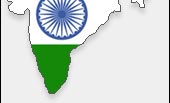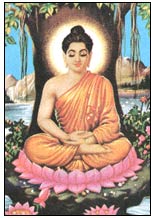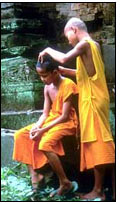


 |
The history of Buddhismgoes back 2 500 years on the regions of present-day Nepal and India, where Buddha (born Gautama) lived. By clicking the map below you find out things about the life of Buddha and his activities in each city. The text further below tells about Gautama and his life in a chronological order. :: birth, childhood and youth :: enlightenment :: teaching :: conclusion :: birth, childhood and youth C. 560 BC King Suddhodana, joka oli Sakhya-heimon hallitsijana nykyisen Nepalin alueella Kapilavatussa , syntyi poika - Siddhartha Gautama. ruler of the Sakhya tribe in Kapilavatu, on the territory of modern-day Nepal, had a son - Siddhartha Gautama. As the son of a rich king Siddhartha was able to live a bachelor's dream in his three castles, while 40 000 female dancers entertained him and the Himalayas provided the scenery. Despite all the wealth and splendor Gautama was not happy with his life. Does this sound familiar? If it does, here is a potential solution: Unsatisfaction drove him at 29 to search for the Truth. With only a begging bowl and a simple robe Siddhartha left his castle during the night - the night, because he was afraid that the smiles of his wife and son would prevent him from leaving. :: enlightenment  Siddhartha spent six years wandering, meditoiden ja opiskellen Pohjois-Intian kuuluisimpien opettajien ohjauksessa filosofisesti rikkaassa ympäristössä.
Siddhartha spent six years wandering, meditoiden ja opiskellen Pohjois-Intian kuuluisimpien opettajien ohjauksessa filosofisesti rikkaassa ympäristössä.
meditating and studying under the guidance of the most famous teachers in Northern India, in an environment rich with philosophy. When those six years were ending, in 528 BC, the first full moon of the month of Vesakha Gautama sat down at the river Niranjana under a peepul tree to meditate, in a place where the town of Bodhgaya is now located, and swore that he would not leave before he had found what he was searching for. That very night he reached, bit by bit, the perfect experience of the truth. By morning he knew that he had found what he had searched for - the unshakable freedom. Siddhartha Gautama had become Buddha, the Enlightened One. :: teaching After his enlightenment Buddha continued his meditation and pondered that he would never be able to communicate his experience to others, and even considered a withdrawal to solitude, but soon understood that his enlightenment was incompatible with selfishness. Only a week later at the Deer Park of Benares Buddha met some ascetics, who at first refused to even greet him, Buddha, who had previously tried ascetism and given it up. However, one by one the ascetics became convinced by his words and impressed by his being. They became Buddha's first disciples. For the next 45 years, he dedicated himself to his cause and spent nine months of each year by walking around Northern India, teaching people from all classes of society. Time and time again Buddha taught people to see their lives with new eyes, and many began to live according to his teachings. :: conclusion  Though not everyone was impressed by his teachings, they had a wide impact in seven states. The rulers of the two greatest kingdoms in Northern India belonged to his disciples. Considering his wide social and cultural influence and large number of followers, it is not surprising that he was also accused of disturbing the social peace.
järkyttämisestä.
Though not everyone was impressed by his teachings, they had a wide impact in seven states. The rulers of the two greatest kingdoms in Northern India belonged to his disciples. Considering his wide social and cultural influence and large number of followers, it is not surprising that he was also accused of disturbing the social peace.
järkyttämisestä.
Buddha also founded sangha, a spiritual community which included people from all castes and social classes - and still do, for the community still flourishes! Buddha died c. 480 BC at the age of 80 in Kushinagar. |
|||||||||||